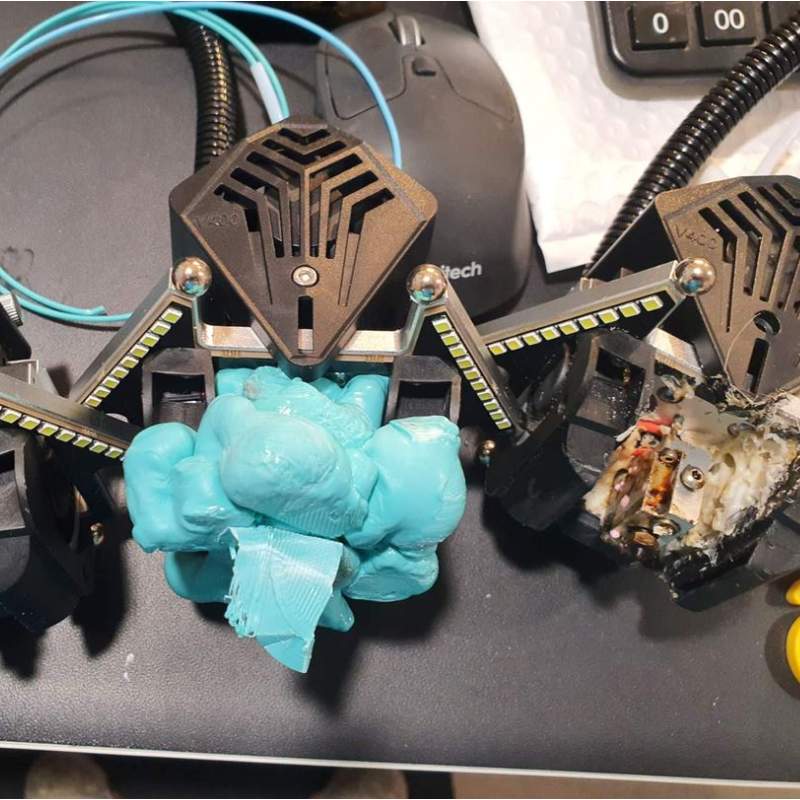The FLSUN V400 Predicament: Unraveling the Cocoon of Clogged Filament

In the realm of 3D printing, a clogged print head is a tale as old as time, or at least as old as the technology itself. It's an issue that can bring even the most sophisticated print jobs to a grinding halt. This was the challenge presented to us when John arrived with his FLSUN V400, its print head enveloped in a chrysalis of hardened filament.

John's predicament was not unusual. The filament had accumulated at the end of the hotend, forming a blockage reminiscent of a cocoon on the verge of releasing a butterfly. This issue typically occurs when the filament fails to adhere to the print bed, instead gathering around the hotend where it hardens into an obstruction.
As we carefully disassembled the print head to assess the damage, we knew that removing this filament buildup required a delicate touch to avoid further damage to the hotend. Using a combination of heat application and precision tools, we meticulously removed the filament, revealing a print head ready for a second chance at life.
Understanding how this issue arises is key to preventing its recurrence. One potential cause is the Z-axis height setting. If the print head is positioned too high, the filament cannot properly adhere to the bed; too low, and it might drag and prevent the filament from extruding correctly. Another contributing factor can be the filament's inability to withstand the high speeds of printing, causing it to misbehave and linger where it's not supposed to.

Once the print head was cleared and reassembled, we turned our attention to the printer settings. Adjusting the Z-axis height is a fine balancing act, requiring a few test prints to get just right. We also advised John on the importance of selecting the appropriate filament for his print speed. Not all materials are created equal, and some may require slower speeds to ensure proper layer adhesion and print quality.
We sent John off with a piece of parting advice that holds true for all 3D printing endeavors: always watch the first two layers. These initial stages are critical as they set the foundation for the entire print. Any issues here can propagate, leading to failures like the one he experienced.
John's printer, now free of its filament entrapment, was ready to return to service. He left our shop not only with a functioning print head but also with the knowledge to avert future print disasters.
In the end, the story of John's FLSUN V400 is a reminder to all 3D printing aficionados that vigilance and proper settings are crucial to the art of 3D printing. With careful observation and the right adjustments, the creation of 3D masterpieces can proceed unencumbered.

John's predicament was not unusual. The filament had accumulated at the end of the hotend, forming a blockage reminiscent of a cocoon on the verge of releasing a butterfly. This issue typically occurs when the filament fails to adhere to the print bed, instead gathering around the hotend where it hardens into an obstruction.
As we carefully disassembled the print head to assess the damage, we knew that removing this filament buildup required a delicate touch to avoid further damage to the hotend. Using a combination of heat application and precision tools, we meticulously removed the filament, revealing a print head ready for a second chance at life.
Understanding how this issue arises is key to preventing its recurrence. One potential cause is the Z-axis height setting. If the print head is positioned too high, the filament cannot properly adhere to the bed; too low, and it might drag and prevent the filament from extruding correctly. Another contributing factor can be the filament's inability to withstand the high speeds of printing, causing it to misbehave and linger where it's not supposed to.

Once the print head was cleared and reassembled, we turned our attention to the printer settings. Adjusting the Z-axis height is a fine balancing act, requiring a few test prints to get just right. We also advised John on the importance of selecting the appropriate filament for his print speed. Not all materials are created equal, and some may require slower speeds to ensure proper layer adhesion and print quality.
We sent John off with a piece of parting advice that holds true for all 3D printing endeavors: always watch the first two layers. These initial stages are critical as they set the foundation for the entire print. Any issues here can propagate, leading to failures like the one he experienced.
John's printer, now free of its filament entrapment, was ready to return to service. He left our shop not only with a functioning print head but also with the knowledge to avert future print disasters.
In the end, the story of John's FLSUN V400 is a reminder to all 3D printing aficionados that vigilance and proper settings are crucial to the art of 3D printing. With careful observation and the right adjustments, the creation of 3D masterpieces can proceed unencumbered.